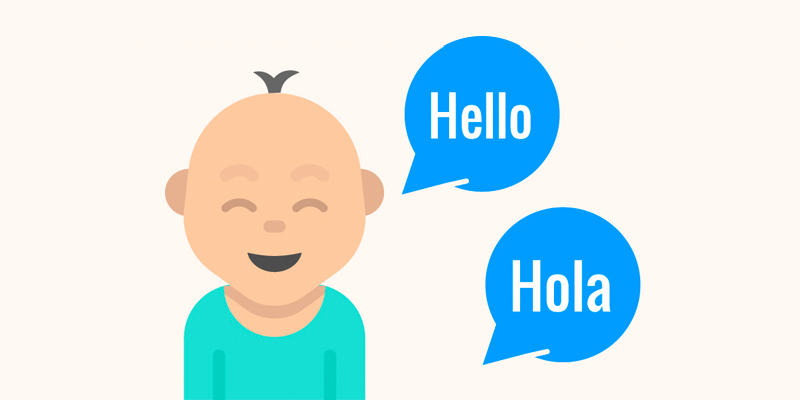

How to Raise a Bilingual Child?

Vera Canto

“The limits of my language mean the limits of my world.” – Ludwig Wittgenstein
According to “The Handbook of Bilingualism”, “Bilingualism – more generally, multilingualism – is a major fact of life in the world today”. Bilingualism is the ability of an individual or the members of a community to use two languages effectively and, in fact, more than half of the world’s population is bilingual or multilingual.
Bilingualism is a spectrum. Many adult bilinguals are “dominant” in one of their languages. Even if the differences between their two languages are subtle, most bilinguals feel slightly more at home in one language than the other in certain settings or for talking about certain topics.
We often consider two types of bilingualism, for the majority of individuals, although there are other options to consider:
- Simultaneous bilingualism – the acquisition of two languages at the same time, typically with both languages introduced prior to the age of 3;
- Sequential bilingualism – a second language introduced after age 3, at which time some level of proficiency has been established in the primary language, also referred to as successive bilingualism or second language acquisition.
As a Speech and Language Therapist, one of the questions I am most frequently asked by parents is “Is it beneficial to raise a child with multiple languages? Won’t he/she get confused?”. Well, in a nutshell, and according to the majority of scientific studies, teaching your child two languages is beneficial. The greatest argument against introducing multiple languages at a young age seems to be that teaching a child more than one language will confuse them or cause delays in their learning. But recent research is proving this wrong.
How to Raise a Bilingual Child?
There are four main methods for raising bilingual children that seem to be the most widespread, so we’ll focus on them and how they can support your child’s bilingual development:
-
One Person, One Language
The One Person, One Language method is where each parent consistently speaks a different language to the child. This could mean that the mother speaks her native Portuguese with her children, while her partner speaks to them in English.
This method is also effective when the two languages used by the parents are different to the main language used outside the home. In other words, it’s still okay even if neither parents’ language is the majority language where the family lives. In the example I used, with a Portuguese speaking mother and an English speaking partner, the family could live in Japan, and thus, the child would learn a third language through school.
The One Person, One Language approach is often regarded as the best method for teaching a child two languages because it is believed that it results in less mixing. It also ensures that your baby has regular exposure to both languages. That said, it requires a lot of dedication from the parents to avoid mixing languages.
-
Minority Language at Home
While children need support in every language they speak, many parents find that a minority language needs extra support. When this is the case, many families adopt the Minority Language at Home approach.
This means that the minority language is used at home by both parents with the children.
For example, both parents speak French at home (whether it is the native language of both parents or not) while living in Germany (where the child learns to speak German outside of the home).
-
Time and Place
The Time and Place method is commonly used in bilingual schools. This could mean that during the morning, everyone speaks one language and in the afternoons everyone speaks another language.
Alternatively, it could mean that Tuesdays and Thursdays are for the majority language, while Mondays, Wednesdays, and Fridays are spent with the local minority language.
Families can adjust this approach as it suits them, and it could even mean a seasonal approach. Perhaps the majority language is used most of the time, while the minority language is used over the weekends or during summer to coincide with a family vacation to the country where the language is spoken.
-
Mixed Language Policy
With the Mixed Language Policy, parents use the language that is appropriate to the situation. For example, the majority language may be used to help with school projects while the minority language may be used to discuss personal topics.
Bilingual Education – Advantages and Disadvantages
Although there is still some discussion about bilingualism / multilingualism and its advantages and disadvantages for the individual and for society, more than ever bilingualism appears to be a necessary qualification within an increasingly tightly connected world. Many studies point to the following advantages:
- The ability to communicate with extended family;
- Open-mindedness and acceptance;
- Future job opportunities;
- Being a “language friendly learner” – they’ll find it easier to acquire more languages later on in life;
- A more diverse cultural upbringing (with literature, films, perspectives, music, games, culture, and so on);
- An increased ability to focus;
- Neuroplasticity;
- Delayed onset of Alzheimer’s disease in comparison to monolinguals.
Myths and Facts – The So Important Question “Will My Child Get Confused?”
One of the biggest concerns that parents have about raising children in a bilingual household is that it will cause confusion.
The short answer is no.
The first question to ask is what confusion would look like. Except in the case of neurological disorders, fluently bilingual adults can speak whatever language they choose in the moment, and are clearly not confused. But what about bilingual children and infants?
One misunderstood behavior, which is often taken as evidence for confusion, is when bilingual children mix words from two languages in the same sentence. This is known as code mixing. In fact, code mixing is a normal part of bilingual development, and bilingual children actually have good reasons to code mix. One reason some children code mix is that it happens frequently in their language communities – children are just doing what they hear adults around them do. A second reason is that, just like young monolinguals, young bilinguals are sometimes limited in their linguistic resources. Similarly to how a monolingual 1-year-old might initially use the word “dog” to refer to any four-legged creature, bilingual children also use their limited vocabularies resourcefully. If a bilingual child does not know or cannot quickly retrieve the appropriate word in one language, he/she might borrow the word from the other language. Rather than being a sign of confusion, code mixing can be seen as a path of least resistance There is also evidence that children’s early code mixing adheres to predictable grammar-like rules, which are largely similar to the rules that govern adults’ code mixing.
If you still have doubts about How to Raise Your Bilingual Child and would like some tips on this subject, please do not hesitate to contact us.
Sources:
- Colin Baker, Colin and Sylvia Prys Jones. Encyclopedia of Bilingualism and Bilingual Education. Multilingual Matters, 1998.
- Bhatia, Tej K. and William C. Ritchie. “Introduction.” The Handbook of Bilingualism. Blackwell, 2006.
- Braunmüller, Kurt and Gisella Ferraresi. “Introduction.” Aspects of Multilingualism in European Language History. John Benjamins, 2003.
- Cortes, Carlos E. Multicultural America: A Multimedia Encyclopedia. Sage Publications, 2013


